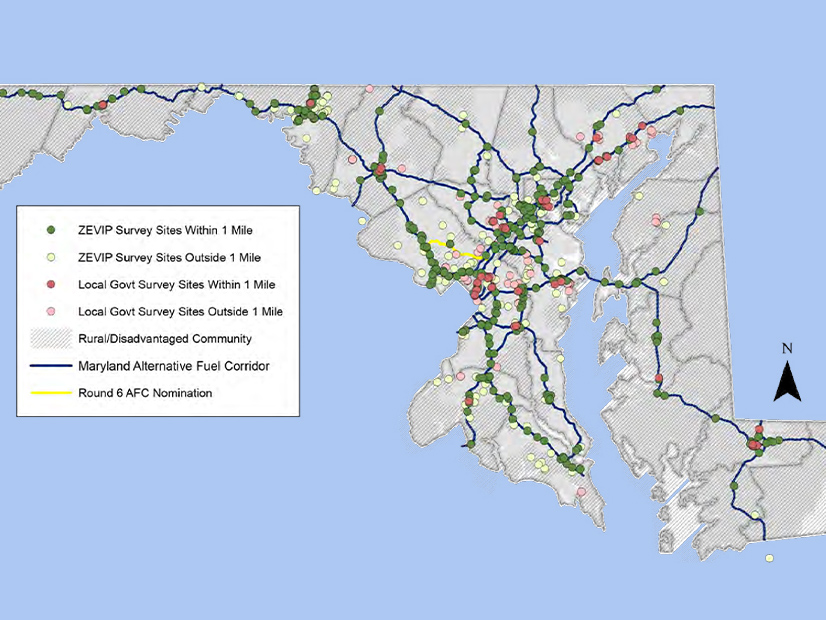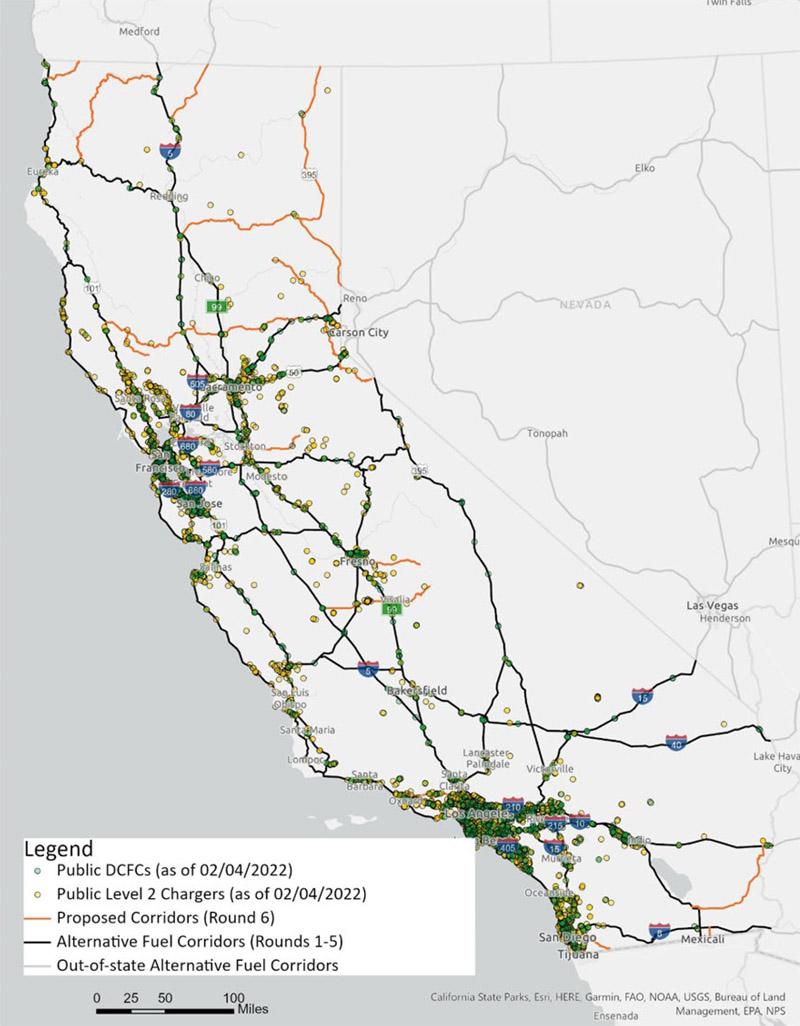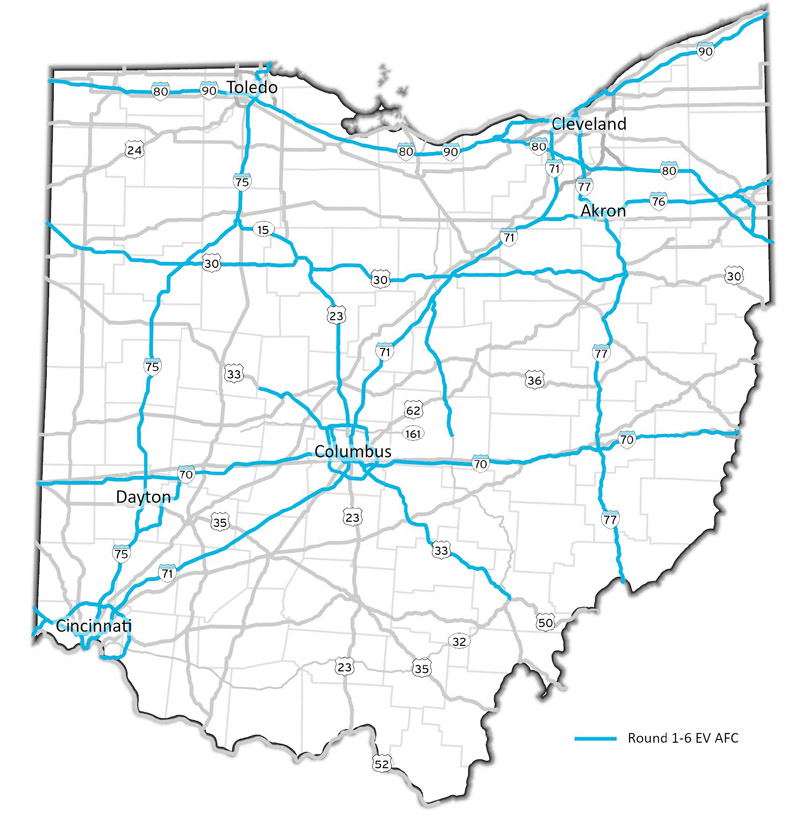
Maryland has identified 502 “optimal” locations where it might install electric vehicle charging stations over the next five years, using the $63 million it is slated to receive from the Infrastructure Investment and Jobs Act (IIJA).

But according to the plan the state recently filed with the Federal Highway Administration (FHWA), not all of the sites are within one mile of key highways, as the funding guidelines require.
Maryland is also one of several states raising concerns about whether its electric system will be able to interconnect and integrate multiple charging stations, each with four 150-kW DC fast charging ports, which are also required under the National Electric Vehicle Infrastructure (NEVI) program established by the IIJA.
“Upgrades needed to both the line and load side to meet this increased demand could be extremely costly, especially in areas where the infrastructure may be limited,” the plan said. But the plan also includes a basic assumption that installation costs to be covered with federal funds could include system upgrades as needed.
Maine’s proposed solution to the problem, laid out in its plan, is a staged approach. The initial stage would see the state install charging stations with four 150-kW ports at high-traffic sites, mostly in the southern part of the state. Medium- and lower-traffic sites in the middle and northern regions will only get two 150-kW chargers, at least to start.
Monday was the deadline for all 50 states, Puerto Rico and the District of Columbia to file their NEVI plans with the FHWA, and the agency reported on Tuesday that all had met the deadline. The FHWA now has until Sept. 30 to review and approve the plans.

The program will provide a total of $5 billion in formula funding to the states over the next five years, with the goal of building out a national network of 500,000 chargers that will make EV charging safe, convenient and affordable. (See Biden Administration to Order EV Charging Standards.)
Still, like Maine and Maryland, many states have raised concerns about their ability to meet all the program guidelines and may be asking for “exceptions” to allow them to get their plans approved and start receiving funds. (See EV Charging Standards Leave Some Obstacles Untouched.)
The exception process is intended to provide states with flexibility on some of NEVI’s core requirements, said Steve Lommele, a senior project manager with the Joint Office of Energy and Transportation (JOET) launched by the Energy and Transportation departments earlier this year to help states with their plans. For example, under the NEVI guidelines, the IIJA-funded EV chargers must be installed every 50 miles along interstate highways, and no more than one mile off these routes.
California, which did not identify specific exceptions in its plan, asked that the FHWA allow for exceptions to be requested at any time throughout the NEVI program. “Flexibility in requesting exceptions will be especially important in the rural areas of the state,” the plan said.

“There are certainly sections of rural highway, particularly in the Western United States, where there might not be much at all along a 50-mile stretch of highway, Lommele said during a recent webinar on state planning for NEVI, sponsored by the nonprofit Advanced Energy Economy (AEE). “So, it might be worth considering expanding that to 55, 60 or 70 miles.
“There might be a town with amenities that’s a bit further than one mile from the highway, and so states are, in some cases, requesting exceptions because we want these to be convenient locations that have amenities,” he said.
Renee Samson, director of regulatory affairs at FreeWire Technologies, an EV charger manufacturer, raised yet another concern during the AEE webinar that “sites that may not be able to support four charging [ports] or have no economic need or do not have enough EV drivers.” Echoing Maine’s approach, she said, such locations “might be better suited to have one to begin with and then work towards that goal” of having four ports.
Lommele said the JOET and most states have been working closely with utilities to develop strategies for deploying increasing numbers of DC fast chargers in the coming years. “It really starts with close collaboration and working together to understand where the infrastructure is going to go, where maybe some stations will be more difficult,” he said.
“By and large, states are probably going to be focusing on the lower hanging fruit to start, the areas where there may be less significant challenges, and then, as we kind of develop best practices and learn from deployments, using that information to inform investment in the later years,” he said.
An FHWA spokesperson also stressed that “these plans will be updated annually, and the build-out of a national network will continue to evolve over the coming several years. But we are confident that we will have a truly national and publicly available EV charging network that builds consumer confidence in the growing number of EVs that automakers are offering.”
Changing NEVI Requirements
Installing the fast chargers every 50 miles on major interstate routes is the top priority for the first round of NEVI funds, creating a national network of Alternative Fueling Corridors, or AFCs. But previous guidelines for AFCs, set before passage of the IIJA, allowed for fast chargers of less than 150 kW and as far as five miles off a corridor, rather than one mile. The current guidelines were issued in February and further updated in June.
 California already has an extensive network of public EV chargers in populated areas. | Caltrans
California already has an extensive network of public EV chargers in populated areas. | CaltransIn addition to the 50-mile and 150-kW requirements, the June updates also require fast chargers to be available 24/7, operating 97% of the time and able to accept any debit or credit card. The program also requires states to contribute 20% of the cost of building out the charging stations on their AFCs.
These updates have meant some states needed to quickly rethink their plans. Slated to receive $21.1 million in NEVI funds, Vermont already had a plan for putting fast chargers along its highways based on the previous federal guidelines. As a result, the state currently has no locations with more than two 150-kW ports, and fast charging stations that the state has funded and built along its AFCs mostly have two 50-kW plugs.
Further, of the 15 sites for NEVI charging stations identified in Vermont’s plan, four will fall outside the one-mile zone and may need to apply for exceptions.
With 565,000 EVs on the road, California is the country’s leading EV market and will get $384 million in NEVI funds over the next five years. The state has already installed 28,877 public Level 2 chargers and 6,764 public fast chargers, but only 592 fast chargers within one mile of a key highway exit are 150 kW, according to figures in the state’s draft NEVI plan.
Fast charging stations installed on the state’s highways “before the NEVI requirements were introduced … may serve as prime locations and critical sites to be upgraded,” the plan says. In addition, fast charging sites that were developed with funds from the California Energy Commission must be wired to accommodate 150-kW chargers, the plan says.
California is planning a competitive bidding process in which developers will be asked to identify potential sites for NEVI-compliant charging stations “based on an analysis of gaps in the current network, future charger needs and geography,” as well as the minimum NEVI requirements, the plan says.
‘Fail Early and Often’
With nearly $408 million in federal funds, Texas took a different approach to NEVI planning, starting without an existing EV policy blueprint, said Ryan Granger, a strategic planning manager at the state’s DOT, also speaking at the AEE webinar.
 Ohio only has 10 charging stations that are NEVI-compliant but is analyzing highway interchanges across the state to identify additional sites. | Ohio Dept. of Transportation
Ohio only has 10 charging stations that are NEVI-compliant but is analyzing highway interchanges across the state to identify additional sites. | Ohio Dept. of Transportation“We didn’t have any state goals. We were able to focus on the [federal] requirements in the plan and getting that done,” he said. “We wanted to fail early and often and learn from people telling us what we were doing wrong.”
Like Maine, Texas is planning for a phased rollout of EV charging infrastructure, with an initial focus on AFCs, adding 55 new sites to 27 preexisting charging stations installed by private companies, Granger said. In subsequent years, the state will target installing charging stations in rural counties, small urban areas and county seats, which, Granger said, “are pretty centrally located.”
In states with smaller, still-developing EV markets, such as Ohio, the process for identifying charging sites begins with an analysis of highway interchanges with existing electric infrastructure that could support four 150-kW chargers, the state’s plan says. With only 10 NEVI-compliant DC fast charging stations at present, Ohio is looking for interchanges with one or more truck stops, one or more retail centers or big box stores, or three or more gas stations or convenience stores.
Potential sites meeting those criteria are then analyzed by the local utility to “confirm the sites are viable or [have] capacity constraints that would add costs,” the plan says.
In Ohio, which is eligible for $140 million in NEVI funding, the state’s DOT had “an initial conversation” with the state’s utilities, said Luke Stedke, managing director of communications and policy, “overlaying our sites with their grids.”
How the utilities will meet the future demand from DC fast chargers is something each utility will have to develop with the Public Utilities Commission, he added.
FreeWire’s Samson also cautioned that states and utilities will need to provide developers with appropriate pre-application information to ensure that a site will be able to connect to the grid and not get caught in a long interconnection queue.
“Handling the utility connection upfront and showing that a site will indeed be able to be built out is going to be important for ensuring that there’s a smoother process than what it potentially could be,” she said.
Facing Workforce Shortages
Beyond geography and the grid, another common theme across many state plans is the need for workforce development. California has estimated that its existing statewide goals for light-, medium- and heavy-duty EVs and associated infrastructure will require a charging installation workforce of 47,300 to 71,500 job-years ― the equivalent of one person working a full-time job for one year ― over 2021-2031.
The state is tapping into a range of partnerships, including an apprenticeship program “for new and innovative sectors,” run by the Foundation for California Community Colleges. The state has also developed on-the-job training programs focused on EV supply equipment installations and service, including basic safety training.
Oregon, slated for $52 million in funding, also sees the NEVI program as a “significant opportunity” for workforce development, but the state’s plan acknowledges “there is insufficient qualified labor to complete these deployments, especially when considering certification requirements.”
The plan says the state’s DOT is in discussions with utilities and unions regarding the status of the local certified workforce and workforce development needs.
Samson pointed to the Electric Vehicle Infrastructure Training Program (EVITP), a national program to certify electricians to work on installing EV chargers. Some states are requiring that charging stations be installed by EVITP-certified electricians when “there simply aren’t enough electricians that are certified in certain areas of the country. … Making [it] a requirement is going to add complexity and expense to a project when you have to have electricians travel quite some distance to do installations,” she said.
California’s plan noted that, as of May, large areas of the state served by AFC-designated highways had no local contractors appearing on the state’s EVITP published list. To reduce the risk of a shortage of needed electricians, the California Energy Commission will contract with community colleges to expand the locations of in-person EVITP examinations outside the San Francisco and Los Angeles areas.
Workforce training may also be critical for state plans to meet federal “Justice 40” requirements that 40% of the benefits of federally funded projects go to disadvantaged communities. As noted in California’s plan, AFCs don’t, in general, run through or close to disadvantaged or low-income areas, either in dense urban areas or more remote rural regions.
Lommele of JOET said that “one aspect of [NEVI] benefits could be creating workforce opportunities for disadvantaged communities.
“States are engaging with disadvantaged communities to understand what benefits are important, what needs those communities have and how the program can support that,” he said.
The IIJA also provides $2.5 billion for competitive, discretionary grants to fill the gaps in EV charger infrastructure not covered by the NEVI formula funds. Guidelines for those funds are expected later this year, the FHWA said, and will further build out the national network by making investments in community charging.
“The NEVI formula program is really intended to be a backbone of a national network,” Lommele said. “It’s going to continue to require additional public and private investment to meet the needs five years from now, but we’re really working toward a future where everyone can ride and drive electric.”



